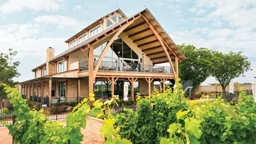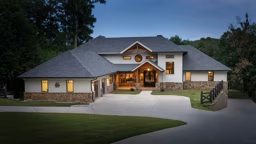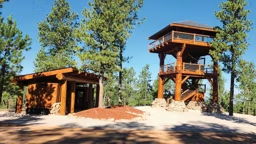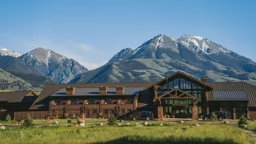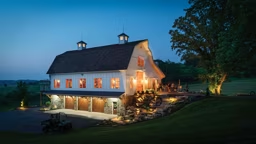Bob Kuhl likes to get his hands dirty. Couple that notion with his yearning to become a gentleman farmer, and it makes sense why he and his wife, Joyce, decided to move into a restored barn located in the middle of Texas.
Though they had been long-time residents of Austin, steeped in the town’s laid-back attitude, they became increasingly enamored with thoughts of country living.
“It’s been a dream of ours to live in a historic home, which probably was a direct influence from my parents, who both loved history,” Joyce explains. She also credits staying in a New England country inn on their honeymoon and the extensive photo collection of historic buildings that has been both a comfort and resource over the years.
See also New Life for Old Barns
A Piece of History
Bob determined it was time to make a jump toward fulfilling the dream on more land than the suburban Austin lot they had called home for the past 22 years. “Now or never was our approach,” Bob recalls. He and Joyce attended a log and timber frame show in the winter of 2005. It probably wasn’t an accident that they found Doug Walsh, manager of Heritage Restorations, at the show. The company, based in Waco, Texas, specializes in reclaiming historic timbers.“I invited Joyce and Bob to visit Heritage’s property and take a look at our assortment of vintage buildings,” Doug says.
The gift shop, fashioned from an antique New England barn, caught Joyce’s eye. “I took it all in, thinking of how nice it would be to convert a barn into a house much like this one,” she says.
That spark ignited the Kuhls’ passion as they pushed forward with the idea of finding an old barn. “Doug invited us up to Heritage’s second location in Albany, New York, where we toured four barns in one day. None of them turned our heads until we saw a massive four-bent, three-bay working barn filled to the brim with hay,” Joyce remembers. “We both looked at each other thinking the same thing…this was it.”

Barn Raising
Heritage’s Amish team in Albany disassembled the mid-18th century barn, loading the historic hemlock timbers carefully onto flatbeds for transport to the Kuhls’ 34-acre property in Jerrell, Texas. Under prior agreement, Heritage would act as the general contractors for the project but Bob was in charge of clearing the property, which was filled with native elm and scrub oak. The work was hard, but the site emerged as the perfect spot for the barn frame, which would be set on a concrete slab.The couple eagerly anticipated the arrival of the timbers which rolled in by the truckload on a clear spring day. Joyce, a fourth-grade teacher, decided to make the event into a field trip, thinking it would be fun to have her class witness an honest-to-goodness barn-raising. “Despite the fact that I worked less than 15 minutes away, somehow we were late and missed the whole affair,” she says. She reconciles that it still was a sight for the kids, who all received wood pegs and still left happy.
Once the frame was secured in place, the Kuhls felt elation mixed with trepidation. “It’s daunting to see this skeleton of a house secured only by pegs and not think it’s going to blow away,” Bob says. Fears aside, work proceeded on the home the Kuhls had designed in conjunction with Heritage and local Georgetown architect, Rick O’Donnell. “In order to get a bank loan we had to have an architect configure the space. He’s the one that actually drew out the plans for the size of the closets, the shower, and so on, within the barn’s expansive shell,” Bob says.
The folks at Heritage encouraged the Kuhls to keep the integrity of the barn and not solidify their plans for door and window opening until after they saw the whole barn enclosed with structural insulated panels (SIPs).
“This was a smart recommendation,” Joyce says. “Usually people put in these elements before they move in. We’re glad we waited. Just like we’re glad we took painter’s tape and moved it around to get a good feel for room sizes. You have this very large breadth of space and it’s open to your own individual interpretation. We’re happy we lived with the space first, then mapped out the three-bedroom, three-bath interior area.”

Choosing Simplicity
What the couple developed throughout the eight-month building process was a desire to always err on the side of simplicity. “No matter how complex our ideas became, we wanted to preserve the simple beauty of this historic barn. We didn’t want to chop up the rooms with hallways but wanted to showcase the extensive timberwork, that still has some writing that’s decipherable on the beams, and vaulted ceiling,” Joyce says.Troy Dumont, supervisor with Heritage, gave the Kuhls the idea of incorporating a second-story loft. “By building a loft,” Troy says, “they succeeded grandly, increasing the useable square footage along with impressive visibility to the beam work.”
“We are so glad we took Troy’s recommendation,” Bob says. “The loft area is clearly a dramatic vantage point from the wrought-iron balcony, whether you’re on the first or second story, which by the way, was built with an amazing old wood threshing floor.”
Like much of Texas Hill Country architecture, masonry was used for the home’s façade. Random chopped Autumn Blend sandstone was chosen for its rustic, indigenous appeal. “It took the masons two weeks but it was worth it,” Bob says. “The house looks totally integrated into the woodsy setting.”
As the exterior work progressed, the interior finishing, headed by lead handyman, Bryan Koenig, carefully continued with Bob and Joyce’s on-site approval.
“Though we moved in as the house was in progress, it enabled us to get a true feel for how we wanted to furnish,” Joyce says. “Our early American furniture and antiques looked perfect once we oiled and finished the pine floors.”
Similarly, they were happy with Bryan’s expert craftsmanship inside. “Our flat-paneled shaker cabinetry and doors, the farmhouse sink in the kitchen, tin ceiling in the kitchen/dining area…everything turned out simple yet elegant,” Joyce says.
If the Kuhls were to retrace their steps, they admit they would design larger bedrooms and bigger closets. But, “that’s why you have a three-bay garage,” Bob laughs. “It’s all a learning process and we are extremely pleased with how the house turned out. Everyone involved removed all of the anxiety from the process so that Joyce and I could have a lot of fun. It’s a delight to be living in a part of history.”
Resources:
Heritage Restorations, (800) 841-6351, heritagebarns.com




